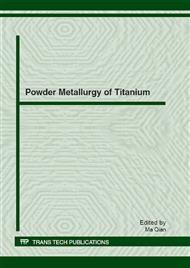p.276
p.281
p.289
p.295
p.301
p.309
p.314
p.320
p.330
Ti-6Al-4V Billet Produced by Compaction of BE Powders Using Equal-Channel Angular Pressing
Abstract:
In the present study, ECAP compaction was used to produce Ti-6Al-4V billet from CP Ti powder mixed with two different Al-V master alloys. It was demonstrated that ECAP at 400 °C with applied back-pressure of about 210 MPa permits consolidation of the powder mixtures to relative green densities as high as 99.3 %. A combination of temperature, high hydrostatic pressure and plastic shear deformation gave rise to excellent green densities and good compositional homogeneity due to enhanced self-diffusion. It was shown that the temperature of sintering required after direct compaction of BE powders can be reduced by 150-250°C if compaction is conducted by ECAP with back-pressure. This becomes possible due to high green density and the presence of a large number of fast diffusion paths associated with dislocations and grain boundaries. It is suggested that the ECAP-based processing route may offer a significant saving of production cost.
Info:
Periodical:
Pages:
301-308
Citation:
Online since:
August 2012
Authors:
Price:
Сopyright:
© 2012 Trans Tech Publications Ltd. All Rights Reserved
Share:
Citation:


